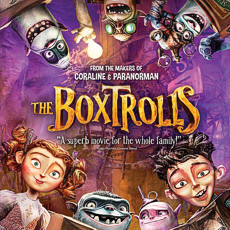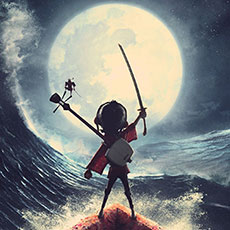Laika Animation/Focus Features (September 26 2014), Universal Home Entertainment (January 20 2015), 2 discs, 96 mins plus supplements, 1080p high-definition 1.78:1 widescreen , DTS-HD Master Audio 5.1, Rated PG, Retail: $49.98
Storyboard:
A young lad, raised by trolls that wear old boxes to cover their modesty, finds out who he really is and how he can defeat the twisted Archibald Snatcher to bring the human and boxtroll worlds back together…
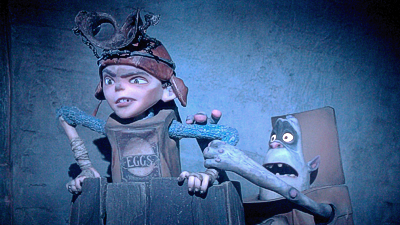
The Sweatbox Review:
Just as Pixar’s 1995 groundbreaker Toy Story set the stage for practically every animated CGI family film to follow, it’s increasingly obvious that Tim Burton’s The Nightmare Before Christmas from a couple of years before remains the yardstick and clear inspiration for the majority of stop-motion features (that don’t come from the Aardman studios) that have come since and, it has to be said, remain in its shadow. None more true is this than about the pictures from Laika Studios, which itself launched with a film from Nightmare‘s director, Henry Selick, the very well received Coraline, in which the Burton influence was very prevalent.
The feeling continues, right from the opening scenes, in their latest movie, The Boxtrolls, an elaborate fantasy which actually seems to have more of a visual and tonal connection to Nightmare than even Burton’s later Corpse Bride and, especially, the strangely distant Frankenweenie. However, Selick has long been gone from the studio, and this film’s world of Cheesebridge, production influences aside, isn’t Burton’s world, however deep the similarities may run, and as The Boxtrolls played out it was refreshing to also spot clear influences from classic Disney, Aardman’s films, Fantastic Mr Fox (perhaps its closest kin), and even a bit of Monty Python (an element pleasingly confirmed in the end credits).

Visually The Boxtrolls is spectacular, with a hugeness in scale that has become a Laika trademark, but totally preserving the magic that stop-motion has over the super-smoothness of CG. While not perhaps as so fluid as the sublimely animated ParaNorman, which sometimes resembled something rendered on a computer as opposed to the hand-crafted look and feel of stop-motion, The Boxtrolls conversely has that unmistakable tactile touch…its exquisite animation providing a fine showcase for its artists, clearly the best in the business at this point, and this kind of animation artform.
However, when it comes to their stories, Laika struggle to compete with their closes rivals Aardman, and here again I wasn’t sure why Eggs, the human boy the trolls have taken in and raised as one of their own, wore a box (marked “Eggs”, hence the name) on top of his regular clothes underneath, other than for a need to fit in which isn’t particularly explored. Likewise, I wasn’t too sure about the context of the story…we’re kind of dropped right into proceedings, with Eggs’ adoption by the trolls, his ability to suddenly speak after years being raised by grunting creatures, and the trolls’ own backstory all very vague in the movie’s execution.
That said, The Boxtrolls does zip through its running time and, even if it’s not always conventionally coherent, the various scenes whizz through and there’s always something happening, even if we’re not always sure what, or why. Also, the second half becomes much more focused, especially when we do get that much-needed trolls backstory, why Eggs fits into their world and a long-thought lost character makes a late reappearance, although there still feels a slight disconnect between some of the principal vocalists and their visual counterparts, especially newcomer Isaac Hempstead Wright being the most inexperienced, and Elle Fanning (otherwise so great in Super 8 and Maleficent), whose character displays more in her many excellent visual expressions than through her not young enough sounding voice.
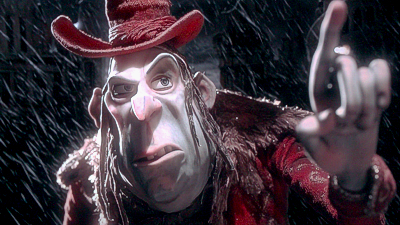
The best of them is none other than Ben Kingsley as arch villain Archibald Snatcher, really having fun and playing with the confines of an animation vocal, reminding me of Horace from One Hundred And One Dalmatians, and Timothy Spall in snivelling grovel mode, particularly his parts in Enchanted and as Beadle Bamford in Burton’s Sweeney Todd. Snatcher really is a magnificent villain, and the film is easily Kingsley’s to own, largely spreading a broad theatricality throughout the film that’s also present in the intricate design, where a little Hammer Horror filters through the foggy streets, and the trolls themselves are often reminiscent of Sleeping Beauty’s goblins and the original Gremlins in vision and sound.
So with the strength of a good villain we can boo and hiss at in Kingsley’s Snatcher and the visually inventive feast of so many different melting pot references, why didn’t The Boxtrolls perform more healthily at the box office? Release dates play a part, of course, and the film came at the tail end of How To Train Your Dragon 2‘s massively successful run but slightly too early to catch the Halloween slot that The Book Of Life went on to do very well in, but it seems Universal have been pleased enough with their returns on the film as they have extended their deal with Laika for a further number of outings.
Releasing under Universal’s “independent” Focus Features label as opposed to the main unit’s home to Illumination Entertainment and their Despicable Me franchise, Laika and their films certainly have their own voice, with none of their features so far falling into any discernible category and a stubborn unwillingness to play to the easy commercial mentality just to boost the bottom line – you could even say they think outside the box! As such their films can take a turn out of left field and, although The Boxtrolls is more straight forward and enjoyable a film than their last, ParaNorman, there are still one or two somewhat random, what the heck and occasionally gross or scary moments to be had here.
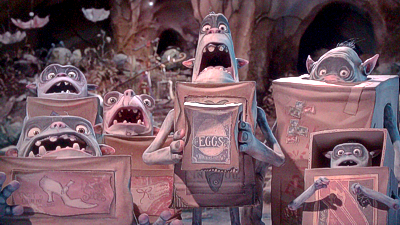
Otherwise, however, The Boxtrolls at least represents something different in animation to all the played-for-laughs animal buddy movies we usually get, and it’s a kids film that, as with Laika’s breakthrough Coraline, will provide a little more stimulation for younger eyes as a result. It’s not as solid a film as that, and everything all gets a bit Wild Wild West with its giant mechanical monster towards the end but, whatever else, this is a unique film in the current mainstream animation landscape, and one that doesn’t allow itself to be categorised in any one box, which in itself really is quite refreshing.
Is This Thing Loaded?
As has been the case with each Laika feature to come to disc before it, Universal has packed everything it can into the box to reveal all about the animated stop-motion filmmaking process. Top of the list is a Feature Commentary with directors Graham Annable and Anthony Stacchi, who talk just as much about developing the story as they do about the animation, elaborating upon the differences between the book and their film. With what they say here, it sounds as if the book needed quite a slimming down in order to work for the screen, and although it does shed light on some of the more random moments and choices, it also suggests where the film may have struggled to get its ideas across. It’s a good track, since the filmmakers have delved so fully into the Boxtrolls’ world that they’re able to speak on all the aspects of the production, though it’s not always particularly engrossing and some revealed CG tricks actually take away from the presumed stop-motion awesomeness.
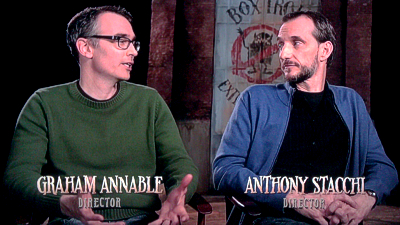
A group of near-twenty minutes’ worth of Preliminary Animatic Sequences offers up optional commentary with the director duo but also includes good few deleted or alternate moments and concepts, coming from the storyboard process of the film when elements were subject to change. Dare To Be Square: The Making Of The Boxtrolls runs a bunch of production featurettes (Voicing The Boxtrolls, Inside The Box, The Big Cheese: Allergy Snatcher, Deconstructing The Dance and Think Big: The Mecha Drill) to over a half hour of behind the scenes content, covering the vast scope of the making of the film from voices to effects with enough discussion so as to cover the basics and more, although again the number of CG tricks do detract from the overall achievement: great as that technology may be in creating larger scale sequences it does feel that a lot of “cheats” have been deployed here.
A further selection of behind the scenes featurettes looks into several aspects of the production with a little more of a promotional slant, although the play all option runs them all (The Nature Of Creation, Trolls Right Off The Tongue, Allergic To Easy, Let’s Dance and On The Shoulders Of Giants) as something of an additional “making of” lasting nearly 15 minutes. Everything from the design and manufacturing of the sets and props, to the Boxtrolls’ language and animation is touched on and, although there’s some repetition in these pre-release pieces, they offer an alternate approach and are great to have on the disc itself.
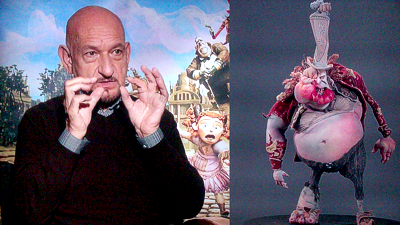
The disc also sports some teasers for other Universal family titles, with a hitherto unknown about Curious George 3: Back To The Jungle (with cheaper looking animation closer to the TV show than the theatrical first or video sequel) and The Tale Of Princess Kaguya playing at the top of the disc, and Blu-ray teasers for The Nut Job, the Despicable movies, Laika’s previous pair (Coraline and ParaNorman) and a somewhat questionable new outing for The Little Rascals, Save The Day, which feels a touch freaky, archaic and just a little bit wrong on several levels, for whatever various reasons.
Case Study:
A standard BD case’s sleeve art is replicated on a nice slipcover, different to the standard non-3D edition. Being a 3D set, it was a surprise to see a dimensional lenticular card on the front of the cover as was the norm when BD-3D discs first started to emerge. Not always successful at presenting the artwork to an advantage (like the dimming effect result of having to wear the 3D specs to watch a film, I sometimes found the lenticular sleeves took just as much away from the clarity of the image as they did add a supposed depth), here the effect works well enough and the decent print quality helps the characters to come alive on the front of the box.
Ink And Paint:
This edition of The Boxtrolls offers up both the “flat” and 3D versions on just the one disc along with all the extras, so we can only assume that the separately available flat version is a BD25 disc that replicates one of the layers of this dual-layer 50gb BD that serves both formats in one. If not then it’s a sorry state of affairs when the space-hogging 3D doesn’t get the bandwidth it really needs and the flat edition also doesn’t get room to shine as it should, but having said that I couldn’t see any issues relating to compression problems and the short-ish hour and a half length means there isn’t too much packed on the platter. In terms of the added-D, the tactile nature of real sets and figures plays to the strengths of the stop motion technique, with enough of a handful of pop-out shots to match the usual use of depth in the format.

Scratch Tracks:
Matching the intricate visuals, the mostly bombastic DTS-HD Master Audio track pulls out all the stops, and although I’ve made my comments clear as regards to many of what I felt were lackluster vocalists, the rest of the soundtrack is as first rate as one would expect from a Skywalker Sound mix. English, Spanish and French flavors are all available in their 5.1 DTS-HD MA originals.
Final Cut:
With more than a touch of Roald Dahl, there’s a quirky Britishness that extends throughout The Boxtrolls, mainly down to the many Britcom vocalists (including Nick Frost, Richard Ayoade and Simon Pegg) and even a song contributed by Python’s Eric idle. Ben Kingsley’s stab at an animated villain steals the show for sure, but once again Laika’s visual mastery isn’t always matched by its storytelling. That said, there’s lots to see in The Boxtrolls that keeps it visually interesting, and Universal’s typically packed disc (too pricey at $50 retail for the 3D when the standard edition can be had for just over $20 after discounts) once again reveals the extraordinary work that goes into Laika’s stop-motion process and ticks all the boxes.
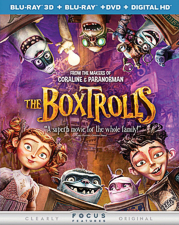 | ||
 |



